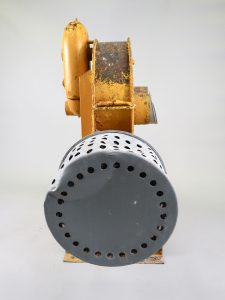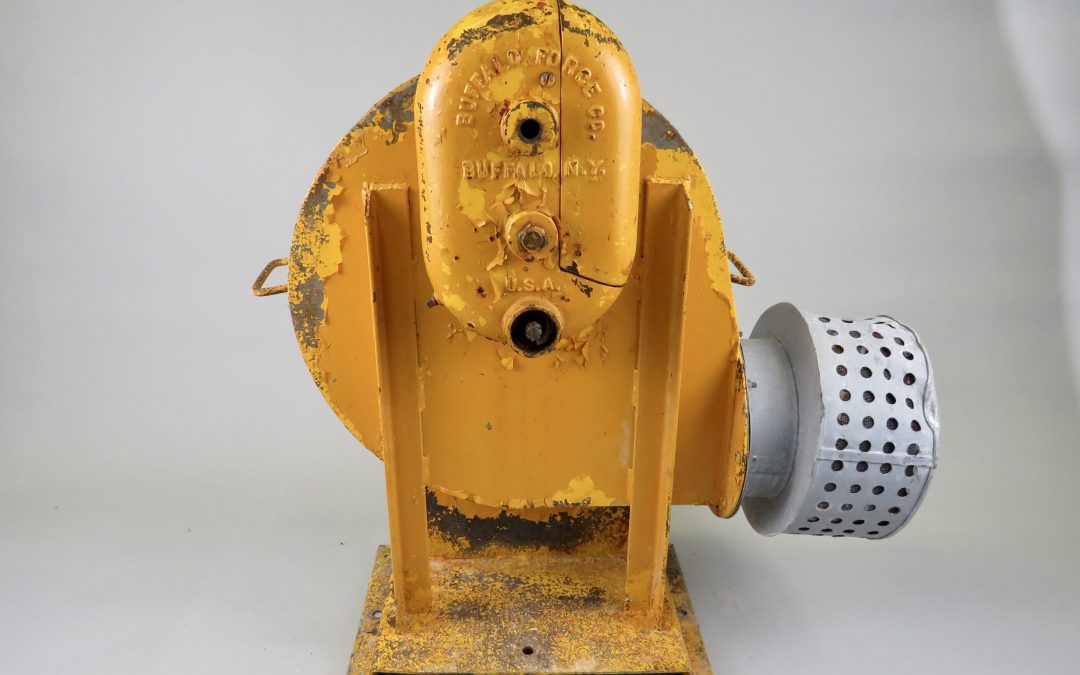(10/25)
As Archaeology Month comes to a close, this week’s artifact feature in ongoing celebration of our 25th anniversary is a fan from The Buffalo Forge Company, which was designed for use in fallout shelters.
The Buffalo Forge Company was formed in 1878 by young entrepreneur William F. Wendt. With the help of various partners, including his own brother, Wendt got involved in America’s industrial expansion through the development of blacksmith forges. Later, Wendt continued to grow the company by adding heating equipment, exhaust machines, dust collectors, and more to their product line. The Buffalo Forge Company operated plants in Canada, the United States, and Mexico, where they manufactured these products for residential and commercial use.
In 1901, a man by the name of Willis Haviland Carrier joined The Buffalo Forge Company working as an engineer and just under a year later in 1902, he submitted drawings for what became recognized as the world’s first modern air conditioning system. Carrier took inspiration from a cooling system developed in 1842 by John Gorrie, which used compressor technology to create ice, and this helped to cool and dry the air. With this, Carrier studied the laws of humidity to develop a system that could be more efficient in controlling humidity. He devised a system of fans, ducts, heaters, and perforated pipes which collectively became the world’s first air conditioner.

Buffalo Forge Fan, Diefenbunker Museum: 2001.005.001
Carrier’s invention was successful in controlling humidity, improving air circulation and ventilation, and cleaning the air. Thanks to Carrier, particular Buffalo Forge Company products became essential inventions for preparedness during the Cold War. This particular fan in the Diefenbunker’s collections was specifically designed for fallout shelters as it provided positive pressure to air movement. The fan would push the contaminated air outward and would not allow any incoming unfiltered air to enter a shelter. Though it is missing from this particular fan, ventilation in most shelters was activated by a hand crank attached to the blower. This fan is yellow, circular in shape, and constructed of metal. It has handles on either side of the fan and has a grey filter attached at the base. Running parallel to the filter is an opening where a pipe responsible for circulation would have connected the fan out to the surface. Inscribed at the top of the fan is “Buffalo Forge Co. N.Y. U.S.A.” This fan comes from the Canadian Emergency Preparedness College (formally the Canadian Civil Defence College) that once existed in Arnprior, Ontario between 1985 and 2003.

Another example of a Buffalo Forge fan on display at the Diefenbunker shows where the pipe and hand crank should be attached.
Heating, ventilation, and air conditioning systems have come a long way over the years, which is evident in the Diefenbunker’s original 1960s construction. We have recently made huge strides in upgrading the Diefenbunker’s aging HVAC infrastructure, which has allowed us to continue safeguarding this one-of-a-kind national historic site. The Diefenbunker is home to thousands of artifacts and is an artifact itself, therefore it is imperative that the museum is temperature-controlled to ensure the preservation of Canada’s most significant Cold War artifact for generations to come.
Stay tuned as we continue to celebrate our 25th anniversary by uncovering stories from our museum’s collections.
Read other stories on our blog.
